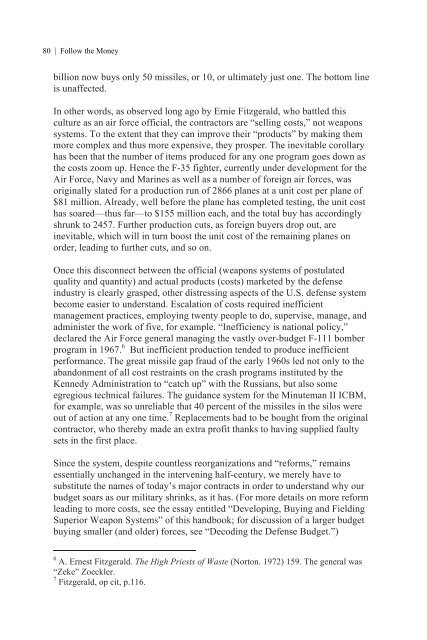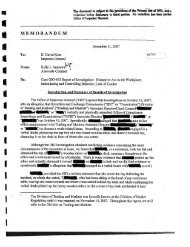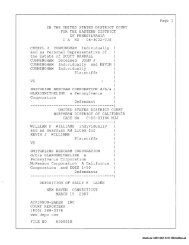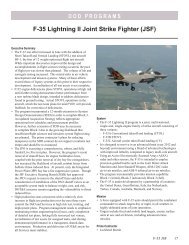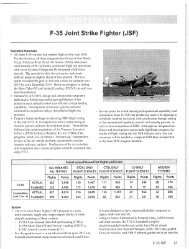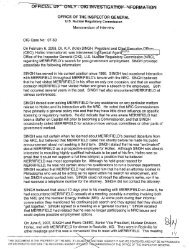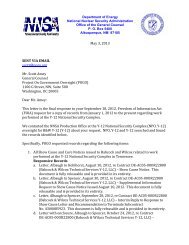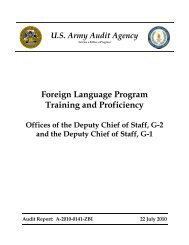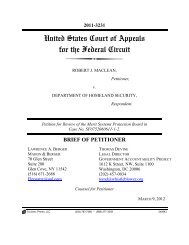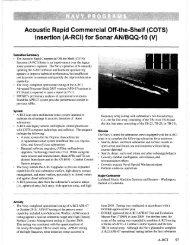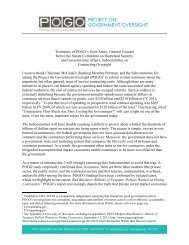The Pentagon Labyrinth
The Pentagon Labyrinth
The Pentagon Labyrinth
Create successful ePaper yourself
Turn your PDF publications into a flip-book with our unique Google optimized e-Paper software.
80 | Follow the Money<br />
billion now buys only 50 missiles, or 10, or ultimately just one. <strong>The</strong> bottom line<br />
is unaffected.<br />
In other words, as observed long ago by Ernie Fitzgerald, who battled this<br />
culture as an air force official, the contractors are “selling costs,” not weapons<br />
systems. To the extent that they can improve their “products” by making them<br />
more complex and thus more expensive, they prosper. <strong>The</strong> inevitable corollary<br />
has been that the number of items produced for any one program goes down as<br />
the costs zoom up. Hence the F-35 fighter, currently under development for the<br />
Air Force, Navy and Marines as well as a number of foreign air forces, was<br />
originally slated for a production run of 2866 planes at a unit cost per plane of<br />
$81 million. Already, well before the plane has completed testing, the unit cost<br />
has soared—thus far—to $155 million each, and the total buy has accordingly<br />
shrunk to 2457. Further production cuts, as foreign buyers drop out, are<br />
inevitable, which will in turn boost the unit cost of the remaining planes on<br />
order, leading to further cuts, and so on.<br />
Once this disconnect between the official (weapons systems of postulated<br />
quality and quantity) and actual products (costs) marketed by the defense<br />
industry is clearly grasped, other distressing aspects of the U.S. defense system<br />
become easier to understand. Escalation of costs required inefficient<br />
management practices, employing twenty people to do, supervise, manage, and<br />
administer the work of five, for example. “Inefficiency is national policy,”<br />
declared the Air Force general managing the vastly over-budget F-111 bomber<br />
program in 1967. 6 But inefficient production tended to produce inefficient<br />
performance. <strong>The</strong> great missile gap fraud of the early 1960s led not only to the<br />
abandonment of all cost restraints on the crash programs instituted by the<br />
Kennedy Administration to “catch up” with the Russians, but also some<br />
egregious technical failures. <strong>The</strong> guidance system for the Minuteman II ICBM,<br />
for example, was so unreliable that 40 percent of the missiles in the silos were<br />
out of action at any one time. 7 Replacements had to be bought from the original<br />
contractor, who thereby made an extra profit thanks to having supplied faulty<br />
sets in the first place.<br />
Since the system, despite countless reorganizations and “reforms,” remains<br />
essentially unchanged in the intervening half-century, we merely have to<br />
substitute the names of today’s major contracts in order to understand why our<br />
budget soars as our military shrinks, as it has. (For more details on more reform<br />
leading to more costs, see the essay entitled “Developing, Buying and Fielding<br />
Superior Weapon Systems” of this handbook; for discussion of a larger budget<br />
buying smaller (and older) forces, see “Decoding the Defense Budget.”)<br />
6 A. Ernest Fitzgerald. <strong>The</strong> High Priests of Waste (Norton. 1972) 159. <strong>The</strong> general was<br />
“Zeke” Zoeckler.<br />
7 Fitzgerald, op cit, p.116.


